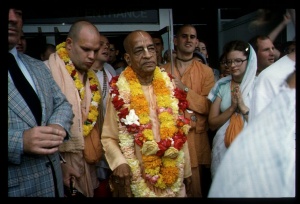CC Madhya 6.120 (1975)

A.C. Bhaktivedanta Swami Prabhupada
Below is the 1996 edition text, ready to be substituted with the 1975 one using the compile form.
TEXT 120
- vedānta paḍāite tabe ārambha karilā
- sneha-bhakti kari’ kichu prabhure kahilā
SYNONYMS
vedānta—Vedānta philosophy; paḍāite—to instruct; tabe—then; ārambha—beginning; karilā—made; sneha—affection; bhakti—and devotion; kari’—showing; kichu—something; prabhure—unto the Lord; kahilā—said.
TRANSLATION
He then began to instruct Lord Caitanya Mahāprabhu on Vedānta philosophy, and out of affection and devotion, he spoke to the Lord as follows.
PURPORT
The Vedānta- or Brahma-sūtra, written by Śrīla Vyāsadeva, is a book studied by all advanced spiritual students, especially by the sannyāsīs of all religious communities (sampradāyas). The sannyāsīs must read the Vedānta-sūtra to establish their final conclusions concerning Vedic knowledge. Here, of course, the Vedānta mentioned is the commentary of Śaṅkarācārya, known as Śārīraka-bhāṣya. Sārvabhauma Bhaṭṭācārya intended to convert Caitanya Mahāprabhu, who was a Vaiṣṇava sannyāsī, into a Māyāvādī sannyāsī. He therefore made this arrangement to instruct Him in the Vedānta-sūtra according to the Śārīraka commentary of Śaṅkarācārya. All the sannyāsīs of the Śaṅkara-sampradāya enjoy seriously studying the Vedānta-sūtra with the Śārīraka-bhāṣya commentary. It is said, vedānta-vākyeṣu sadā ramantaḥ: “One should always enjoy the studies of the Vedānta-sūtra.”